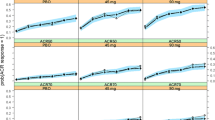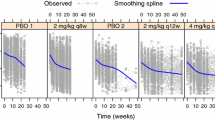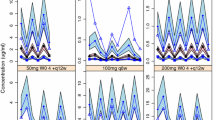Abstract
Accurate exposure–response modeling is important in drug development. Methods are still evolving in the use of mechanistic, e.g., indirect response (IDR) models to relate discrete endpoints, mostly of the ordered categorical form, to placebo/co-medication effect and drug exposure. When the discrete endpoint is derived using change-from-baseline measurements, a mechanistic exposure–response modeling approach requires adjustment to maintain appropriate interpretation. This manuscript describes a new modeling method that integrates a latent-variable representation of IDR models with standard logistic regression. The new method also extends to general link functions that cover probit regression or continuous clinical endpoint modeling. Compared to an earlier latent variable approach that constrained the baseline probability of response to be 0, placebo effect parameters in the new model formulation are more readily interpretable and can be separately estimated from placebo data, thus allowing convenient and robust model estimation. A general inherent connection of some latent variable representations with baseline-normalized standard IDR models is derived. For describing clinical response endpoints, Type I and Type III IDR models are shown to be equivalent, therefore there are only three identifiable IDR models. This approach was applied to data from two phase III clinical trials of intravenously administered golimumab for the treatment of rheumatoid arthritis, where 20, 50, and 70 % improvement in the American College of Rheumatology disease severity criteria were used as efficacy endpoints. Likelihood profiling and visual predictive checks showed reasonable parameter estimation precision and model performance.





Similar content being viewed by others

References
Dayneka NL, Garg V, Jusko WJ (1993) Comparison of four basic models of indirect pharmacodynamic responses. J Pharmacokinet Biopharm 21(4):457–478
Woo S, Pawaskar D, Jusko WJ (2009) Methods of utilizing baseline values for indirect response models. J Pharmacokinet Pharmacodyn 36(5):381–405
Felson DT, Anderson JJ, Boers M, Bombardier C, Furst D, Goldsmith C, Katz LM, Lightfoot R Jr, Paulus H, Strand V et al (1995) American College of Rheumatology. Preliminary definition of improvement in rheumatoid arthritis. Arthritis Rheum 38(6):727–735
Mandema JW, Stanski DR (1996) Population pharmacodynamic model for ketorolac analgesia. Clin Pharmacol Ther 60(6):619–635
Hutmacher MM, Krishnaswami S, Kowalski KG (2008) Exposure–response modeling using latent variables for the efficacy of a JAK3 inhibitor administered to rheumatoid arthritis patients. J Pharmacokinet Pharmacodyn 35(2):139–157
Lacroix BD, Lovern MR, Stockis A, Sargentini-Maier ML, Karlsson MO, Friberg LE (2009) A pharmacodynamic Markov mixed-effects model for determining the effect of exposure to certolizumab pegol on the ACR20 score in patients with rheumatoid arthritis. Clin Pharmacol Ther 86(4):387–395
Hu C, Xu Z, Rahman MU, Davis HM, Zhou H (2010) A latent variable approach for modeling categorical endpoints among patients with rheumatoid arthritis treated with golimumab plus methotrexate. J Pharmacokinet Pharmacodyn 37(4):309–321
Hutmacher MM, French JL (2011) Extending the latent variable model for extra correlated longitudinal dichotomous responses. J Pharmacokinet Pharmacodyn 38(6):833–859
Hu C, Szapary PO, Yeilding N, Zhou H (2011) Informative dropout modeling of longitudinal ordered categorical data and model validation: application to exposure-response modeling of physician’s global assessment score for ustekinumab in patients with psoriasis. J Pharmacokinet Pharmacodyn 38(2):237–260
Hu C, Yeilding N, Davis HM, Zhou H (2011) Bounded outcome score modeling: application to treating psoriasis with ustekinumab. J Pharmacokinet Pharmacodyn 38(4):497–517
Simponi [package insert] (2011) Janssen Biotech, Inc. Horsham, PA
Kremer J, Ritchlin C, Mendelsohn A, Baker D, Kim L, Xu Z, Han J, Taylor P (2010) Golimumab, a new human anti–tumor necrosis factor α antibody, administered intravenously in patients with active rheumatoid arthritis: forty-eight–week efficacy and safety results of a phase III, randomized, double-blind, placebo-controlled study. Arthritis Rheum 62(4):917–928
Weinblatt ME, Bingham CO III, Mendelsohn AM, Kim L, Mack M, Lu J, Baker D, Westhovens R (2012) Intravenous golimumab is effective in patients with active rheumatoid arthritis despite methotrexate therapy with responses as early as week 2: results of the phase 3, randomised, multicentre, double-blind, placebo-controlled GO-FURTHER trial. Ann Rheum Dis. doi:10.1136/annrheumdis-2012-201411
Hu C, Zhou H (2008) An improved approach for confirmatory phase III population pharmacokinetic analysis. J Clin Pharmacol 48(7):812–822
Cox DR, Hinkley DV (1979) Theoretical statistics. Chapman & Hall/CRC Press LLC, Boca Raton
Karlsson MO, Holford N (2008) A tutorial on visual predictive checks. Population Approach Group in Europe. Abstract 1434. http://www.page-meeting.org/?abstract=1434. Accessed 20 Dec 2012
Emery P, Fleischmann RM, Moreland LW, Hsia EC, Strusberg I, Durez P, Nash P, Amante EJ, Churchill M, Park W, Pons-Estel BA, Doyle MK, Visvanathan S, Xu W, Rahman MU (2009) Golimumab, a human anti-tumor necrosis factor α monoclonal antibody, injected subcutaneously every four weeks in methotrexate-naive patients with active rheumatoid arthritis: twenty-four–week results of a phase III, multicenter, randomized, double-blind, placebo-controlled study of golimumab before methotrexate as first-line therapy for early-onset rheumatoid arthritis. Arthritis Rheum 60(8):2272–2283
Keystone EC, Genovese MC, Klareskog L, Hsia EC, Hall ST, Miranda PC, Pazdur J, Bae SC, Palmer W, Zrubek J, Wiekowski M, Visvanathan S, Wu Z, Rahman MU (2009) Golimumab, a human antibody to tumour necrosis factor α given by monthly subcutaneous injections, in active rheumatoid arthritis despite methotrexate therapy: the GO-FORWARD Study. Ann Rheum Dis 68(6):789–796
Acknowledgments
The authors thank the anonymous reviewers for their insightful and constructive suggestions and the Medical Affairs Publications Group of Janssen Services, LLC, for their editorial support.
Author information
Authors and Affiliations
Corresponding author
Appendix: Alternative representations of baseline-normalized IDR model forms
Appendix: Alternative representations of baseline-normalized IDR model forms
We first derive two reduction-from-baseline IDR model forms not given in Woo et al. [2]. From Eq. 1, it follows that the reduction from baseline, R1 = R0 − R, with R1(0) = 0, is governed by:
The derivation mathematically holds whether R > R0 or R ≤ R0. The importance of this general interpretation will become more apparent in the next section. It is noted that Eq. 10 from Woo et al. [2] was derived by defining baseline subtraction as |R − R0| and then taking its derivative. While the absolute value function is formally non-differentiable, their derivation is valid when R − R0 > 0. The case of R − R0 ≤ 0 is provided here by Eq. 9.
It may appear to follow that, when fd(t) is interpreted as a Type III IDR model in Eq. 8, the term Smax equals Imax in Eq. 6 and hence may not exceed 1. However this constraint is unnecessary and can be removed by suitable baseline choices. Thus, the equivalence between Type I and Type III IDR model interpretations only holds in the context of an increase/decrease from baseline.
The proportional reduction-from-baseline IDR model form, although not used in the other parts of this manuscript, is next derived for completeness. Let R2 = (R0 − R)/R0, then R2(0) = 0, and:
Note that this model form has one less parameter than Eq. 10 in Woo et al. [2], specifically kin.
Symmetries between Type I and Type III IDR models
For Type I and III IDR models, H2(t) = 0, and Eq. 9 becomes:
Therefore, R1 takes the form of a Type III or Type I increase-from-baseline IDR model form as Eq. 10 in Woo et al. [2], depending on whether R is Type I or Type III.
Perhaps surprisingly, such symmetry does not exist between Type II and IV IDR models. This can be seen by taking H1(t) = 0 in Eq. 9, which then becomes:
This has the extra non-zero term of −2 kout H2(t) R1 than Eq. 10 in Woo et al. [2].
Relationship with the latent variable approach
Next, we derive the differential equation for a more general form than the latent variable approach represented by Eqs. 6 and 7. Let R1 = fd(t), H(t) be the inhibitory term in Eq. 6, and R = R(t), then, noticing kin = kout, one has:
which takes the form of Eq. 9 with DE = R0 = kin/kout. That is, fd(t) takes the form of a reduction-from-baseline IDR model.
For the interpretation of Eq. 8, let R2 = −fd(t) = −R1, one has:
which takes the form of Eq. 10 from Woo et al. [2], with DE = R0 = kin/kout. That is, gd(t) = −fd(t) takes the form of an increase-from-baseline IDR model.
Rights and permissions
About this article
Cite this article
Hu, C., Xu, Z., Mendelsohn, A.M. et al. Latent variable indirect response modeling of categorical endpoints representing change from baseline. J Pharmacokinet Pharmacodyn 40, 81–91 (2013). https://doi.org/10.1007/s10928-012-9288-7
Received:
Accepted:
Published:
Issue Date:
DOI: https://doi.org/10.1007/s10928-012-9288-7



